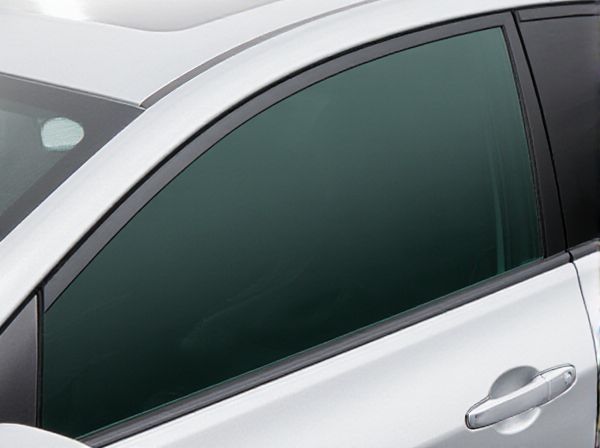
Photo illustration: Solar Control Glass vs Standard Tint
Solar control glass significantly reduces heat and UV radiation entering your space, enhancing comfort and energy efficiency compared to standard tint. Unlike regular window tint, solar control glass incorporates advanced coatings that reflect infrared and ultraviolet rays without sacrificing visibility. Choosing solar control glass can lower cooling costs and protect interior furnishings from fading more effectively than traditional tinting options.
Table of Comparison
| Feature | Solar Control Glass | Standard Tint |
|---|---|---|
| Heat Reduction | Blocks up to 70% of solar heat | Blocks up to 35% of solar heat |
| UV Protection | Blocks 99% of harmful UV rays | Blocks up to 60% of UV rays |
| Glare Reduction | High glare resistance for safer driving | Moderate glare reduction |
| Durability | Scratch-resistant coating | Prone to fading and peeling |
| Visibility | Maintains clear visibility day and night | Can reduce nighttime visibility |
| Energy Efficiency | Reduces air conditioning usage | Minimal impact on energy savings |
| Cost | Higher upfront investment | Lower initial cost |
Introduction to Solar Control Glass and Standard Tint
Solar control glass incorporates a special coating that reflects and absorbs solar radiation, reducing heat gain and glare while maintaining high visible light transmission. Standard tint, typically a dyed film applied to glass, primarily reduces glare and improves privacy but has limited effectiveness in blocking infrared heat. The advanced technology in solar control glass offers superior energy efficiency and comfort compared to traditional tinting methods.
How Solar Control Glass Works
Solar control glass works by incorporating special coatings that reflect and absorb infrared radiation, reducing heat transmission while allowing visible light to pass through. Unlike standard tint, which primarily darkens the glass to block sunlight, solar control glass maintains clarity and improves energy efficiency by minimizing solar heat gain. This technology helps lower cooling costs and enhances indoor comfort without compromising natural daylight.
Standard Tint: Features and Functionality
Standard tint reduces glare and limits visible light transmission, enhancing driving comfort and privacy. It primarily blocks some UV rays but offers limited heat rejection compared to solar control glass. Standard tint is cost-effective and easy to apply, making it popular for basic window shading without significantly altering energy efficiency.
Heat Reduction Capabilities Compared
Solar control glass significantly outperforms standard tint in heat reduction by reflecting and absorbing infrared radiation, which can block up to 70% or more of solar heat gain. Standard tint primarily reduces visible light glare but offers limited protection against infrared heat, typically reducing heat transmission by only 20-30%. The advanced coatings on solar control glass enhance energy efficiency by maintaining cooler indoor temperatures and reducing the need for air conditioning.
Light Transmission and Glare Control
Solar control glass significantly reduces light transmission compared to standard tint by blocking up to 70% of solar heat while maintaining natural daylight clarity. Its advanced coatings minimize glare effectively, enhancing visual comfort without darkening interiors. Standard tint primarily reduces brightness by filtering visible light but lacks the sophisticated heat rejection and precise glare control found in solar control glass.
Energy Efficiency and Cost Savings
Solar control glass significantly outperforms standard tint by reflecting and absorbing up to 70% of solar heat, reducing indoor temperatures and lowering air conditioning costs. Its advanced coatings enhance insulation, cutting energy consumption for heating and cooling by 20-30%. Over time, this improved energy efficiency translates into substantial cost savings and increased building comfort compared to conventional tinted glass.
UV Protection Differences
Solar control glass offers significantly enhanced UV protection by blocking up to 99% of harmful ultraviolet rays, reducing skin damage and interior fading compared to standard tints that typically block only 35-60% UV radiation. This advanced filtration is achieved through specialized coatings or embedded particles in solar control glass, which maintain clarity while providing superior protection. Consequently, solar control glass is ideal for environments requiring high UV defense, such as vehicles, commercial buildings, and residential spaces.
Aesthetic and Design Considerations
Solar control glass offers superior aesthetic appeal by maintaining clear visibility and reducing glare without compromising natural light, unlike standard tint that darkens windows and can distort colors. Its advanced coatings provide a sleek, modern look, enhancing architectural design while preserving exterior views. Choosing solar control glass supports energy-efficient design without sacrificing style, making it ideal for contemporary buildings focused on both form and function.
Durability and Maintenance
Solar control glass offers superior durability compared to standard tint, featuring enhanced resistance to scratches, fading, and weathering due to its advanced manufacturing processes and protective coatings. Maintenance requirements for solar control glass are lower since its surface repels dirt, reduces grime buildup, and maintains clarity without frequent cleaning or reapplication of films. Standard tint films often degrade over time with exposure to UV rays and temperature fluctuations, leading to peeling, discoloration, and the need for regular replacement or upkeep.
Choosing the Right Solution for Your Needs
Solar control glass reduces heat and glare more effectively than standard tint by reflecting infrared rays while maintaining natural light transmission. Standard tint primarily darkens windows to block visible light, offering limited UV protection and less energy efficiency compared to solar control glass. Selecting the right solution depends on factors like climate, energy savings goals, privacy needs, and budget constraints for optimal comfort and performance.
 caratoz.com
caratoz.com